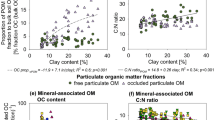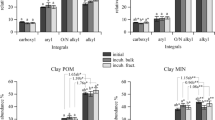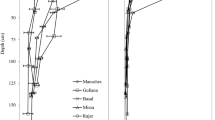Abstract
Sequential density fractionation separated soil particles into “light” predominantly mineral-free organic matter vs. increasingly “heavy” organo-mineral particles in four soils of widely differing mineralogy. With increasing particle density C concentration decreased, implying that the soil organic matter (OM) accumulations were thinner. With thinner accumulations we saw evidence for both an increase in 14C-based mean residence time (MRT) of the OM and a shift from plant to microbial origin.Evidence for the latter included: (1) a decrease in C/N, (2) a decrease in lignin phenols and an increase in their oxidation state, and (3) an increase in δ13C and δ15N. Although bulk-soil OM levels varied substantially across the four soils, trends in OM composition and MRT across the density fractions were similar. In the intermediate density fractions (~1.8–2.6 g cm−3), most of the reactive sites available for interaction with organic molecules were provided by aluminosilicate clays, and OM characteristics were consistent with a layered mode of OM accumulation. With increasing density (lower OM loading) within this range, OM showed evidence of an increasingly microbial origin. We hypothesize that this microbially derived OM was young at the time of attachment to the mineral surfaces but that it persisted due to both binding with mineral surfaces and protection beneath layers of younger, less microbially processed C. As a result of these processes, the OM increased in MRT, oxidation state, and degree of microbial processing in the sequentially denser intermediate fractions. Thus mineral surface chemistry is assumed to play little role in determining OM composition in these intermediate fractions. As the separation density was increased beyond ~2.6 g cm−3, mineralogy shifted markedly: aluminosilicate clays gave way first to light primary minerals including quartz, then at even higher densities to various Fe-bearing primary minerals. Correspondingly, we observed a marked drop in δ15N, a weaker decrease in extent of microbial processing of lignin phenols, and some evidence of a rise in C/N ratio. At the same time, however, 14C-based MRT time continued its increase. The increase in MRT, despite decreases in degree of microbial alteration, suggests that mineral surface composition (especially Fe concentration) plays a strong role in determining OM composition across these two densest fractions.







Similar content being viewed by others
References
Amelung W, Zhang X, Flach KW (2006) Amino acids in grassland soils: climatic effects on concentrations and chirality. Geoderma 130:207–217. doi:10.1016/j.geoderma.2005.01.017
Arnarson TS, Keil RG (2001) Organic–mineral interactions in marine sediments studied using density fractionation and X-ray photoelectron spectroscopy. Org Geochem 32:1401–1415. doi:10.1016/S0146-6380(01)00114-0
Baisden WT, Amundson R, Cook AC, Brenner DL (2002) Turnover and storage of C and N in five density fractions from California annual grassland surface soils. Global Biogeochem Cycles 16:64–116
Baldock JA, Skjemstad JO (2000) Role of the soil matrix and minerals in protecting natural organic materials against biological attack. Org Geochem 31:697–710. doi:10.1016/S0146-6380(00)00049-8
Basile-Doelsch I, Amundson R, Stone WE, Borschneck D, Bottero JY, Moustier S, Masin F, Colin F (2007) Mineral control of carbon pools in a volcanic soil horizon. Geoderma 137:477–489. doi:10.1016/j.geoderma.2006.10.006
Bellamy PH, Loveland PJ, Bradley RI, Lark RM, Kirk GJD (2005) Carbon losses from all soils across England and Wales 1978–2003. Nature 437:245–248. doi:10.1038/nature04038
Blakemore LC, Searle PL, Daly BK (1987) Methods for chemical analysis of soils. NZ Soil Bur Sci Rep 80, Wellington, NZ
Boström B, Comstedt D, Ekblad A (2007) Isotope fractionation and 13C enrichment in soil profiles during the decomposition of soil organic matter. Oecologia 153:89–98. doi:10.1007/s00442-007-0700-8
Bracewell JM, Campbell AS, Mitchell BD (1970) An assessment of some thermal and chemical techniques used in the study of the poorly-ordered aluminosilicates in soil clays. Clay Miner 8:325–335. doi:10.1180/claymin.1970.008.3.10
Brunauer S, Emmett PH, Teller E (1938) Adsorption of gases in multimolecular layers. J Am Chem Soc 60:309–319. doi:10.1021/ja01269a023
Castanha C, Trumbore S, Amundson R (2008) Methods of separating soil carbon pools affect the chemistry and turnover time of isolated fractions. Radiocarbon 50:83–97
Chapin FSIII, Matson PA, Mooney HA (2002) Principles of terrestrial ecosystem ecology. Springer, NY
Compton JE, Boone RD (2000) Long-term impacts of agriculture on soil carbon and nitrogen in New England forests. Ecology 81:2314–2330
Compton JE, Boone RD (2002) Soil nitrogen transformations and the role of light fraction organic matter in forest soils. Soil Biol Biochem 34:933–943. doi:10.1016/S0038-0717(02)00025-1
Crow SE, Swanston CW, Lajtha K, Brooks JR, Keirstead H (2007) Density fractionation of forest soils: methodological questions and interpretation of incubation results and turnover time in an ecosystem. Biogeochemistry 85:69–90. doi:10.1007/s10533-007-9100-8
Dalal RC, Henry RJ (1988) Cultivation effects on carbohydrate contents of soil and soil fractions. Soil Sci Soc Am J 52:1361–1365
Dalal RC, Mayer RJ (1986) Long-term trends in fertility of soils under continuous cultivation and cereal cropping in southern Queensland. IV. Loss of organic carbon for different density functions. Aust J Soil Res 24:301–309. doi:10.1071/SR9860301
Dijkstra P, Ishizu A, Doucett R, Hart SC, Schwartz E, Menyailo OV, Hungate BA (2006) 13C and 15N natural abundance of the soil microbial biomass. Soil Biol Biochem 38:3257–3266. doi:10.1016/j.soilbio.2006.04.005
Emmerton KS, Callaghan TV, Jones HE, Leake JR, Michelsen A, Read DJ (2001) Assimilation and isotopic fractionation of nitrogen by mycorrhizal fungi. New Phytol 151:503–511. doi:10.1046/j.1469-8137.2001.00178.x
Essington ME (2003) Soil and water chemistry. CRC Press, Boca Raton
Eusterhues K, Rumpel C, Kögel-Knabner I (2005) Organo-mineral associations in sandy acid forest soils: importance of specific surface area, iron oxides and micropores. Eur J Soil Sci 56:753–763
Fontaine S, Barot S, Barre P, Bdioui N, Mary B, Rumpel C (2007) Stability of organic carbon in deep soil layers controlled by fresh carbon supply. Nature 450:277–280. doi:10.1038/nature06275
Golchin A, Oades JM, Skjemstad JO, Clarke P (1994) Study of free and occluded particulate organic matter in soils by solid-state C-13 CP/MAS NMR spectroscopy and scanning electron microscopy. Aust J Soil Res 32:285–309. doi:10.1071/SR9940285
Goñi MA, Hedges JI (1990) Potential applications of cutin-derived CuO reaction products for discriminating vascular plant sources in natural environments. Geochim Cosmochim Acta 54:3073–3081. doi:10.1016/0016-7037(90)90123-3
Grandy AS, Robertson GP (2006) Aggregation and organic matter protection after tillage of a previously uncultivated soil. Soil Sci Soc Am J 70:1398–1406. doi:10.2136/sssaj2005.0313
Grandy AS, Robertson GP (2007) Land-use intensity effects on soil organic carbon accumulation rates and mechanisms. Ecosystems (N Y, Print) 10:58–73. doi:10.1007/s10021-006-9010-y
Gruber N, Galloway JN (2008) An earth-system perspective of the global nitrogen cycle. Nature 451:293–296. doi:10.1038/nature06592
Hedges JI, Mann DC (1979) The characterization of plant tissues by their lignin oxidation products. Geochim Cosmochim Acta 43:1803–1807. doi:10.1016/0016-7037(79)90028-0
Hedges JI, Clark WA, Cowie GL (1988) Organic matter sources to the water column and surficial sediments of a marine bay. Limnol Oceanogr 33:1116–1136
Hobbie EA, Colpaert JV (2003) Nitrogen availability and colonization by mycorrhizal fungi correlate with nitrogen isotope patterns in plants. New Phytol 157:115–126. doi:10.1046/j.1469-8137.2003.00657.x
Holmgren G (1967) A rapid citrate-dithionite extractable iron procedure. Soil Sci Soc Am J 31:210–211
Hua Q, Barbetti M (2004) Review of tropospheric bomb 14C data for carbon cycle modeling and age calibration purposes. Radiocarbon 46:1273–1298
Kaiser K, Guggenberger G (2003) Mineral surfaces and soil organic matter. Eur J Soil Sci 54:1–18. doi:10.1046/j.1365-2389.2003.00544.x
Kaiser K, Guggenberger G (2007) Distribution of hydrous aluminium and iron over density fractions depends on organic matter load and ultrasonic dispersion. Geoderma 140:140–146. doi:10.1016/j.geoderma.2007.03.018
Keil RG, Mayer LM, Quay PD, Richey JE, Hedges JI (1997) Loss of organic matter from riverine particles in deltas. Geochim Cosmochim Acta 61:1507–1511. doi:10.1016/S0016-7037(97)00044-6
Kemmit SJ, Lanyon CV, Waite IS, Wen Q, Addiscott TM, Bird N, O’Donnell AG, Brookes PC (2008) Mineralization of native soil organic matter is not regulated by the size, activity or composition of the soil microbial biomass—a new perspective. Soil Biol Biochem 40:61–73. doi:10.1016/j.soilbio.2007.06.021
Kitayama K, Majalap-Lee N, Aiba S-I (2000) Soil phosphorus fractionation and phosphorus-use efficiencies of tropical rainforests along altitudinal gradients of Mount Kinabalu, Borneo. Oecologia 123:342–349. doi:10.1007/s004420051020
Kleber M, Mikutta AR, Torn MS, Jahn R (2005) Poorly crystalline mineral phases protect organic matter in acid subsoil horizons. Eur J Soil Sci 56:717–725
Kleber M, Sollins P, Sutton R (2007) A conceptual model of organo-mineral interactions in soils: self-assembly of organic molecular fragments into multilayered structures on mineral surfaces. Biogeochemistry 85:9–24. doi:10.1007/s10533-007-9103-5
Kögel-Knabner I, Guggenberger G, Kleber M, Kandeler K, Kalbitz K, Scheu S, Eusterhues K, Leinweber P (2008) Organo-mineral associations in temperate soils: integrating biology, mineralogy and organic matter chemistry. J Plant Nutr Soil Sci 171:61–82. doi:10.1002/jpln.200700048
Kramer MG, Sollins P, Sletten R, Swart PK (2003) N isotope fractionation and measures of organic matter alteration during decomposition. Ecology 84:2021–2025. doi:10.1890/02-3097
Kramer MG, Sollins P, Sletten R (2004) Soil carbon dynamics across a windthrow disturbance sequence in a montane temperate rainforest, southeast Alaska. Ecology 85:2230–2240. doi:10.1890/02-4098
Kramer MG, Lajtha K, Thomas G, Sollins P (2009) Contamination effects on soil density fractions from high N or C content sodium polytungstate. Biogeochemistry 92:177–181. doi:10.1007/s10533-008-9268-6
Lajtha K, Crow S, Yano Y, Kaushal S, Sulzman E, Sollins P, Spears J (2005) Detrital controls on soil solution N and dissolved organic matter in soils: a field experiment. Biogeochemistry 76:261–281. doi:10.1007/s10533-005-5071-9
Leifeld J, Fuhrer J (2005) The temperature response of CO2 production from bulk soils and soil fractions is related to soil organic matter quality. Biogeochemistry 75:433–453. doi:10.1007/s10533-005-2237-4
Marín-Spiotta E, Swanston CW, Torn MS, Silver WL, Burton SD (2008) Chemical and mineral control of soil carbon turnover in abandoned tropical pastures. Geoderma 143:49–62. doi:10.1016/j.geoderma.2007.10.001
Mayer LM (1999) Extent of coverage of mineral surfaces by organic matter in marine sediments. Geochim Cosmochim Acta 63:207–215. doi:10.1016/S0016-7037(99)00028-9
Mayer LM, Xing B (2001) Organic matter-surface area relationships in acid soils. Soil Sci Soc Am J 65:250–258
Medina E, Cuevas E, Figueroa J, Lugo AE (1994) Mineral content of leaves from trees growing on serpentine soils under contrasting rainfall regimes in Puerto Rico. Plant Soil 158:13–21
Oades JM (1989) An introduction to organic matter in mineral soils. In: Dixon JB, Weed SB (eds) Minerals in soil environments, 2nd edn. Soil Science Society of America, Madison, pp 89–159
Opsahl S, Benner R (1995) Early diagenesis of vascular plant tissues; lignin and cutin decomposition and biogeochemical implications. Geochim Cosmochim Acta 59:4889–4904. doi:10.1016/0016-7037(95)00348-7
Perrott KW, Smith B, Inkson R (1976) The reaction of fluoride with soils and soil minerals. Eur J Soil Sci 27:58–67. doi:10.1111/j.1365-2389.1976.tb01975.x
Preger AC, Rillig MC, Johns AR, Du Preez CC, Lobed I, Amelung W (2007) Losses of glomalin-related soil protein under prolonged arable cropping: a chronosequence study in sandy soils of the South African Highveld. Soil Biol Biochem 39:445–453. doi:10.1016/j.soilbio.2006.08.014
Prior CA, Baisden WT, Bruhn F, Neff JC (2007) Using a soil chronosequence to identify soil fractions for understanding and modeling soil carbon dynamics in New Zealand. Radiocarbon 49:1093–1102
Raich JW, Russell AE, Kitayama K, Parton WJ, Vitousek PM (2006) Temperature influences carbon accumulation in moist tropical forests. Ecology 87:76–87. doi:10.1890/05-0023
Rasmussen C, Matsuyama N, Dahlgren RA, Southard RJ, Brauer N (2007) Soil genesis and mineral transformation across an environmental gradient on andesitic lahars. Soil Sci Soc Am J 71:225–237
Rillig M, Caldwell B, Wösten H, Sollins P (2007) Role of proteins in soil carbon and nitrogen storage: controls on persistence. Biogeochemistry 85:25–44. doi:10.1007/s10533-007-9102-6
Siregar A, Kleber M, Mikutta R, Jahn R (2005) Sodium hypochlorite oxidation reduces soil organic matter concentrations without affecting inorganic soil constituents. Eur J Soil Sci 56:481–490. doi:10.1111/j.1365-2389.2004.00680.x
Sollins P, Swanston C, Kleber M, Filley T, Kramer M, Crow S, Caldwell B, Lajtha K, Bowden R (2006) Organic C and N stabilization in a forest soil: evidence from sequential density fractionation. Soil Biol Biochem 38:3313–3324. doi:10.1016/j.soilbio.2006.04.014
Sollins P, Swanston C, Kramer M (2007) Stabilization and destabilization of soil organic matter—a new focus. Biogeochemistry 85:1–7. doi:10.1007/s10533-007-9099-x
Spielvogel S, Prietzel J, Kögel-Knabner K (2008) Soil organic matter stabilization in acidic forest soils is preferential and soil type-specific. Eur J Soil Sci 59:674–692. doi:10.1111/j.1365-2389.2008.01030.x
Stuiver M, Polach HA (1977) Reporting of C-14 data. Radiocarbon 19:355–363
Swanston CW, Torn MS, Hanson PJ, Southon JR, Garten CT, Hanlon EM, Ganio L (2005) Initial characterization of processes of soil carbon stabilization using forest stand-level radiocarbon enrichment. Geoderma 128:52–62. doi:10.1016/j.geoderma.2004.12.015
Tate KR, Theng B (1980) Organic matter and its interactions with inorganic soil constituents. In: Theng B (ed) Soils with variable charge. Soil Bureau, Lower Hutt, pp 225–249
Taylor A, Fransson PM, Högberg P, Högberg MN, Plamboeck AH (2003) Species level patterns in 13C and 15N abundance of ectomycorrhizal and saprotrophic fungal sporocarps. New Phytol 159:757–774. doi:10.1046/j.1469-8137.2003.00838.x
Torn MS, Trumbore SE, Chadwick OA, Vitousek PM, Hendricks DM (1997) Mineral control of soil organic carbon storage and turnover. Nature 389:170–173. doi:10.1038/38260
Torn MS, Lapenis AG, Timofeev A, Fischer ML, Babikov BV, Harden JW (2002) Organic carbon and carbon isotopes in modern and 100-year-old-soil archives of the Russian steppe. Glob Change Biol 8:941–953. doi:10.1046/j.1365-2486.2002.00477.x
Torn MS, Vitousek PM, Trumbore SE (2005) The influence of nutrient availability on soil organic matter turnover estimated by incubations and radiocarbon modeling. Ecosystems (N Y, Print) 8:352–372. doi:10.1007/s10021-004-0259-8
Trumbore SE (1993) Comparison of carbon dynamics in tropical and temperate soils using radiocarbon measurements. Global Biogeochem Cycles 7:275–290. doi:10.1029/93GB00468
Turchenek LW, Oades JM (1979) Fractionation of organomineral complexes by sedimentation and density techniques. Geoderma 21:311–343. doi:10.1016/0016-7061(79)90005-3
Wagai R, Mayer LM (2007) Sorptive stabilization of organic matter in soils by hydrous iron oxides. Geochim Cosmochim Acta 71:25–35. doi:10.1016/j.gca.2006.08.047
Wagai R, Mayer LM, Kitayama K, Knicker H (2009) Climate and parent material controls on organic matter storage in surface soils: a three-pool, density separation approach. Geoderma
Wallander H, Göransson H, Rosengren U (2004) Production, standing biomass and natural abundance of 15N and 13C in ectomycorrhizal mycelia collected at different soil depths in two forest types. Oecologia 139:89–97. doi:10.1007/s00442-003-1477-z
Young JL, Spycher G (1979) Water dispersible soil organic-mineral particles. Soil Sci Soc Am J 43:324–328
Acknowledgments
We thank Gesa Thomas, Lisa Ganio, Dave Beilman, and Sarah Beldin for help with sample and data analyses and graphics. Funding was provided by grants from NSF and USDA NRI to PS and from USDA NRI to KL. Analysis of the Kinabalu soil was facilitated by funding to PS from the Japan Society for the Promotion of Science Fellowship Program as a visiting scientist, and by Prof. K. Kitayama who provided laboratory supplies and facilities at the Center for Ecological Research, Kyoto University. Lastly, we acknowledge the critical contribution of B. A. Caldwell during the inception of this project in introducing us to the extensive literature on preferential sorption of protein to mineral surfaces. Funding for this work was provided by grants from the USDA CSREES NRI program (2002-35107-12249 to KL, 2005-35107-16336 to PS, and 2007-03184 to MK).
Author information
Authors and Affiliations
Corresponding author
Rights and permissions
About this article
Cite this article
Sollins, P., Kramer, M.G., Swanston, C. et al. Sequential density fractionation across soils of contrasting mineralogy: evidence for both microbial- and mineral-controlled soil organic matter stabilization. Biogeochemistry 96, 209–231 (2009). https://doi.org/10.1007/s10533-009-9359-z
Received:
Accepted:
Published:
Issue Date:
DOI: https://doi.org/10.1007/s10533-009-9359-z




